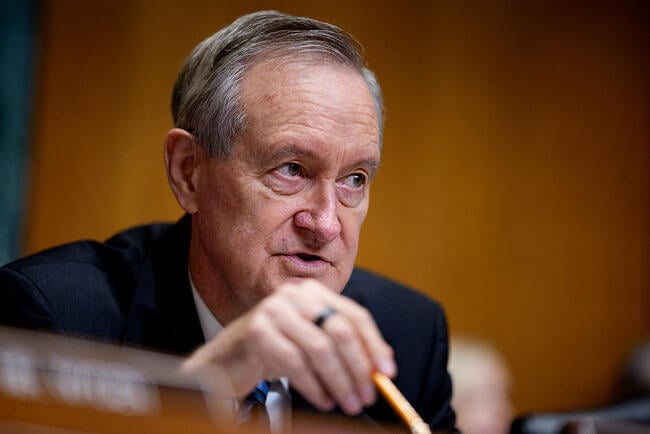You have /5 articles left.
Sign up for a free account or log in.

Sen. Mike Crapo, an Idaho Republican who chairs the Senate Finance Committee, proposed an increase to the endowment tax on private colleges, which first passed in 2017.
The Senate Committee on Finance is proposing to raise the endowment tax on private colleges and universities, but not to the extent the recently passed bill in the House calls for, according to a draft plan released Monday.
The less dramatic excise tax tops out at 8 percent for the wealthiest institutions, compared to 21 percent in the House plan, but the Senate’s proposal keeps the House’s tiered rate structure, with some colleges paying more depending on the value of their endowment per student. The current rate for affected institutions is 1.4 percent.
Institutional lobbyists and college presidents have warned that the sharp increase in the House plan would hurt their ability to provide need-based aid and be debilitating for some low-income students. Although the Senate’s iteration offers some relief, it’s not as much as they hoped for.
“The Senate version of the so-called endowment tax is better, but it’s still bad and harmful tax policy,” said Steven Bloom, assistant vice president of government relations at the American Council on Education. “They’re going to take money that would likely have been devoted to financial aid and research and other academic purposes on campus, and they’re going to send it to Washington, where it’s used largely for purposes unrelated to higher education.”
The Senate committee’s plan, like the House proposal, also still exempts religious colleges and requires colleges to take international students out of the total roll call when calculating the endowment’s value per student. If passed, this stipulation would increase the tax rate significantly for institutions like Columbia University that have 20 percent or more foreign students.
The finance committee legislation, which also includes cuts to Medicaid that could put pressure on states’ budgets, is part of a broader package of bills that would make significant changes to higher education policy and cut spending and taxes in order to pay for President Donald Trump’s priorities, which include increased deportations and tax cuts for the wealthy. The House version of the reconciliation bill known as the One Big Beautiful Bill Act passed by a one-vote margin last month. Senators are aiming to pass their version by July 4 and only need 51 votes thanks to the reconciliation process, as opposed to the traditional 60 votes.
Unlike the House proposal, colleges that don’t accept federal financial aid would be exempt from the tax entirely. Hillsdale College president Larry Arnn blasted the House plan in an op-ed last month as an attack on the institution’s independence. (Hillsdale doesn’t participate in the federal financial aid system.)
“The resources entrusted to Hillsdale College are not drawn from the public treasury,” Arnn wrote. “They are given freely by those who believe in our mission. To tax these gifts is to tax philanthropy itself—to burden those who would lift burdens. It is to weaken those who do good precisely because they are free to do it. It weakens them and strengthens the federal government, reversing the order intended by our Founders.”
Hillsdale wasn’t the only college that pushed back on the rate increase. In recent weeks, private institutions big and small have pitched their own alternatives to Congress.
Some of the largest and wealthiest research institutions that would be affected by the tax—such as Harvard, Stanford and Princeton Universities—pledged to spend 5 percent of their endowment’s value annually in exchange for a much lower 2.4 percent endowment tax rate, The Wall Street Journal reported. Bloom agreed that if the tax is to increase, he would like to see some kind of incentive introduced, such as to encourage schools to spend more on financial aid or research, to mitigate the tax rate.
“They’ve created no incentive for schools to behave in ways that we believe that they would want schools to behave,” he said.
Other institutions suggested that the tax rate should be based on what percentage of endowment revenue an institution spends each year on student financial aid or how many students enrolled come from a low-income background and receive the federal Pell Grant.
A coalition of 24 smaller institutions, including Grinnell and Davidson Colleges, which would be hit hardest by the House endowment tax, proposed adjusting the excise rate based on the number of students enrolled. Colleges with fewer than 5,000 students have a different economic model than an institution with 30,000, they said.
Grinnell president Anne Harris, who spent part of the last week educating lawmakers about the harm of the increased endowment tax, said Monday evening that the Senate plan still disproportionately burdens smaller institutions. She noted that her institution will likely still face the maximum 8 percent tax.
“I deeply appreciate all the work that’s gone on and clearly all the consideration that has informed what we’re seeing this afternoon, but having said that, the current proposal still disproportionately burdens small colleges,” Harris said. “You’re going to find a school like Grinnell College with 1,700 students, a small college in a rural setting, bearing a much greater burden of this tax than a research institution in a large city.”
She could only speculate that senators stuck with a tiered structure for simplicity, but added that “the simple fix” would be to make a stipulation that places all small private colleges in the lowest bracket and maintain the current 1.4 percent tax rate.
Harris is hopeful that there will still be further opportunities for compromise and said she will continue to advocate for small liberal arts institutions like her own. But in the meantime, her executive team will also continue to plan out all the possible scenarios to figure out the best course of action to protect student aid if the bill passes as it currently stands.
“All responsible options that provide the most money for financial aid and mission fulfillment are on the table as part of our scenario planning with the board,” she said.




